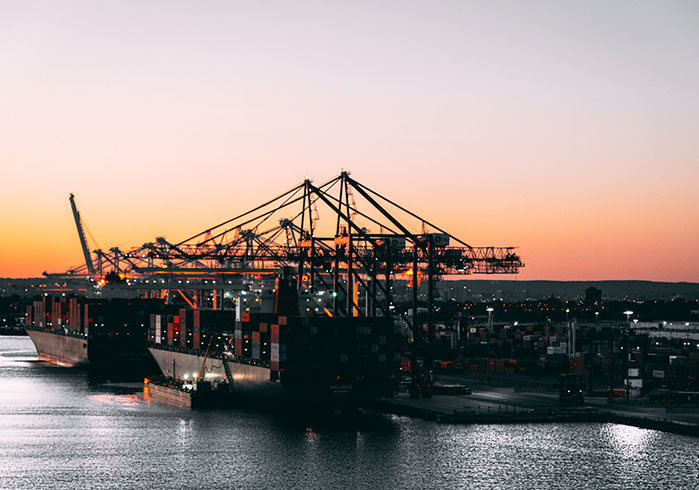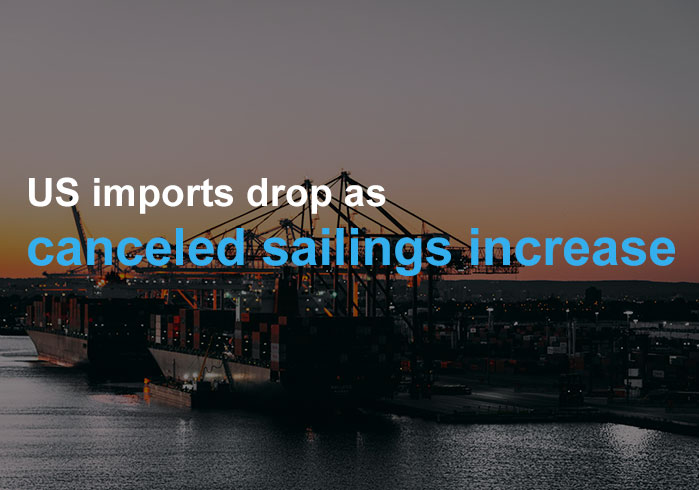
Container lines are giving the world an economic window into the future of land-based cargo flow across the United States. This window gives a sense of the inevitability of post-pandemic hardships much the same as the inevitability of taxes and death.
Container line schedules indicate that seaborne Imports for the United States will fall drastically. This will lower trucking and rail demand to the extent that the loss in seaborne exports can’t be offset by an increased volume of land orders whether it is from domestic producers, distribution centers, or warehouses.
The newest figures are quite astonishing. The Copenhagen-based Sea Intelligence figures have noted that 435 deep-sea sailings have been canceled up until April 25. These losses are results of the reduced demand brought about by the Coronavirus. It equates to a complete loss of 7 million twenty-foot equivalent units of capacity between Europe and the United States. After this report was released additional cancellations were announced by groups like Hapag-Lloyd and Maersk. carriers are starting to show a very high degree of discipline when it comes to capacity management because of this pandemic. The shipping industry has implemented a very forceful response to this turn down in market demand.
Looking forward
Volumes arriving at seaports in the United States are inherently limited because of the capacity of the inbound container ship. This capacity can be determined in advance by way of sailing schedules. Unfortunately, the unannounced departure cancellations extend through July.
That said it can take between 14 and 22 days for a container ship to leave China and reach Los Angeles or Long Beach in California and those leaving China and heading for East Coast ports can take between 30 to 40 days. The current pace of import reductions from the United States is in large part determined by the canceled sailings, affected TEU capacities as well as increased transit time.
Already 13 percent of Trans-Pacific sailings to America that were meant to depart between April 6th and April 13th have been canceled. Cancellations rose to 20 percent between the week of April 13th and April 19th, 28 percent between April 20th and 26, 21 percent for April 27th through May 3rd, and 26 percent for May 3rd through May 9th. It is important to remember that it takes an additional 2 to 6 weeks for the dates of transit for these canceled sailings to have a declining impact on import figures.
Downside risk
Taking into consideration the downside risk, if 20% of arrivals for U.S. ports that were previously scheduled do not show up, the cargo imports through said gateway would drop by a figure of 20% versus what they would have been otherwise but that’s assuming that the slot utilization remains the same. The port volume stands to decline an additional 20% if those non-canceled ships lead to decreased slot utilization.
Yet don’t at the same rate. The approach to blank sailings differs between different alliances and groups/ Hapag-Lloyd has taken on the approach where they announce canceled sailings ranging particularly far in the future, usually well into the end of the second quarter and then they end up supplementing those tactically based on the evolution of the system. However, not every carrier does that. COSCO, for example, announces their blank sailings for a shorter-term into the future and as of right now they haven’t announced potentially canceled sailings for the later part of the second quarter. Put this into perspective, without the Ocean Alliance providing announcements for the second quarter, just going on 2M and THE Alliance, the cancellation for departures between May 25th and July 5th is already between 19% and 21%, with the Ocean Alliance having only successfully canceled 6% during the same time frame.
Given the way that the COVID-19 pandemic has impacted the economy, it stands to reason that these figures will be higher once the Ocean Alliance reveals more blank sailings for the second quarter.
It’s reasonable to expect more service cancellations from carriers because they are now limiting the ability of cargo shippers to book in advance. This in and of itself could disincentivize bookings and shippers are finding it increasingly difficult to properly manage future bookings when so much is in flux. For that reason, Hapag-Lloyd is refusing to accept bookings for more than six weeks in advance as of May 1st.
Effect on rates
These cancellations will affect rates. The higher degree of consolidation could be negative for cargo shippers in the US specifically those who have international supply chains. Amid this pandemic, there is simply too much carrier competition which could prove disastrous for every stakeholder. If volume and pricing end up collapsing, major carriers could go bankrupt and this would destabilize the entire ocean transport system. Thus far the prices have been kept relatively steady which should allow different carriers to remain solvent assuming however that they can maintain the steady prices. The price for a 40-foot equivalent unit container traveling from China to Los Angeles or Long Beach is relatively close to what it was a year ago. This is true for the rates from China to the east coast as well.
Assuming that carriers can reduce capacity in perfect alignment with the drop in demand, these rates should still be down because the cost of fuel has dropped. The cost should be down 44% year-on-year but right now the rates are not significantly lower. Some companies have noted that this is indicative of the resilience of the freight industry and as long as lower oil prices and reduced demand do not undermine rate levels, things should work out for the best.
Wrapping up
Overall, it seems that much hangs in the balance, with companies waiting to verify canceled sailings and the price of sailings before deciding for future action. Shippers should do the best to stay on top of news in their industry, stay ahead of trends, and to maintain flexibility in their businesses and supply chains so they can cope with market volatility.




